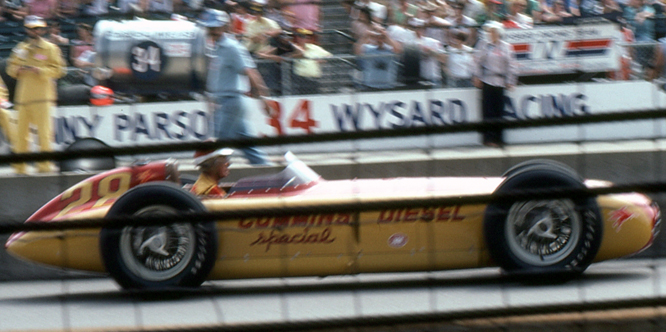Staying with the 1952 Indy 500 which I started to look at yesterday today we are looking at the Cummins Diesel Special, thanks to a photograph taken by Ed Arnaudin in 1982.

The history of Cummins the diesel engine manufacturer dates back to 1919 Clessie Cummins set out to exploit the hitherto unrealised commercial potential of Rudolf Diesels high compression thermal engine which takes it’s name from it’s inventor the diesel engine.
Based in Colombus Indiana Cummins a self taught engineer was also quick to spot opportunities to promote his products through events like the Indy 500 and in 1931 entered a car built around a Duesenberg road car chassis fitted with an 85 hp Cummins deisel marine engine which started last but thanks to it’s fuel economy came home 13th and in the process became the first car ever to complete the Indy 500 without making a pitstop.
This car was subsequently prepared for use on the road and used by Cummins and his marketing manager WG Irwin on a promotional tour of Europe.
In 1934 Cummins returned with a two car entry the #5 powered by a two stroke diesel which went the distance coming in 12th and the #6 by a 4 stroke diesel which retired with transmission failure.
In 1950 Cummins returned to the Brickyard with the #61 Cummins Deisel ‘Green Hornet’ a 340 hp supercharged diesel sitting in a Kurtis Kraft chassis driven by Jimmy Jackson who started 32nd and retired after 50 laps of the rain shortened race. The Green Hornet would take the diesel land speed record at Bonneville after it was timed at 165 mph on the famous salt flats.
For 1952 Cummins held nothing back from their Indy 500 programme working again with Kurtis Kraft the chassis now accommodated a 380 hp 6.6 litre / 401 cui six cylinder turbocharged engine, mandated at twice the size of the gasoline powered vehicles in the race.
The motor featured an aluminium block and head with a magnesium crank case, this unit was lain 5 degrees off flat which gave the #28 three advantages, reduced centre of gravity, reduce the frontal area and thanks to the offset engine some of it’s weight could be distributed so that the car was heavier on the left (inside) wheels.
Fearless Fred Agabashian was hired to drive the Cummins Diesel Special on the recommendation of Kurtis. After the car was tested for the first time the team, comprising almost entirely regular Cummins employees who worked as engineers and mechanics apart from the driver, knew they had a veritable ‘Rocketship’ on their hands.
Fred sandbagged for much of the month of May until Pole day by lifting off on the back straight one lap cruising through a turn on another never completing a whole lap under full power so as not to draw attention to the ‘Rocketship’ capability of the car and risk having the rules changed.
Come 5:45 pm on pole day Fred and the heavy, 3,100 lb, Cummins Diesel Special fitted with a fresh engine made their mark on the world of motor sport by setting an individual lap record of 139 mph and a record 4 lap average of 138 mph.
Qualifying over 1 mph faster than the next nearest competitor in one of the most famous races in the world with a vehicle powered by what was in essence a truck engine subsequently repaid Cummins investment many times over in the volume of publicity this feat generated.
Having shredded their tyres in qualifying the Cummins team needed a different strategy in the race and planned to run a half a tank of diesel and make one pit stop for fuel and tyres. The heavy Cummins Diesel Special was in good company with Ascari and his heavy Ferrari, both cars bogged down at the start but climbed through the field.
Agabashain in the Cummins was running as high as fifth when the car probably claimed a world first, retirement due to…. turbo failure after 71 laps, the air intake for the turbocharger, placed low in the nose, had sucked up debris into the turbine housing damaging the blades.
Cummins however were not in the least disappointed they remain the only manufacturer of truck engines to have recorded an Indy 500 pole. An achievement possibly only eclipsed recently by the 4 victories Audi Diesels in the Le Mans 24 hours since 2006, interrupted by a Peugeot Diesel victory in 2009.
A small post script allegedly in 1953 a spark plug manufacturer was advertising its wares, in the 1953 Indy 500 programe, with a picture of the 1952 Cummins Diesel Special, the only car in the 1952 field without need of them.
My thanks to Steve Arnaudin for scanning and forwarding his Dad’s photograph.
Hope you have enjoyed today’s “Fearless Freddy” edition of ‘Gettin’ a lil, psycho on tyres’ and that you will join me again tomorrow. Don’t forget to come back now !

